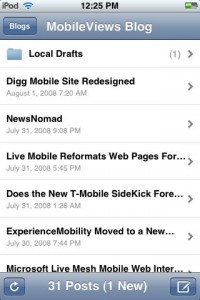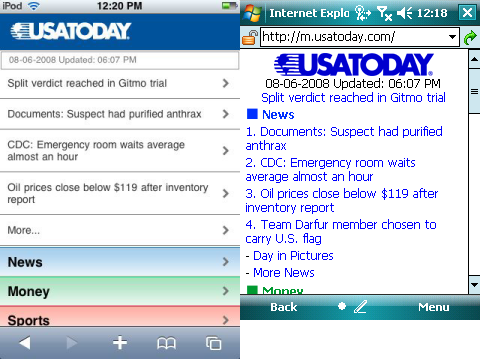I noticed there was an update for my HTC S710 (Vox) Windows Mobile smartphone on the HTC Support site. The upgrade does NOT move the phone to 6.1. However, based on the changes in version numbers, the update may be fairly important. My ROM version went from 1.15.405.2 to 1.34.405.1. The radio version went from 4.1.13.37_02.83.90 to 4.1.13.54_03.10.90. Windows Mobile itself remained at version 6.0 (not 6.1).
Monthly Archives: August 2008
WordPress for iPhone Changed the Way I Blog

It isn’t often that a mobile software tool completely changes the workflow of something I’ve done for a long time or changes the way I think about performing a desktop task. But, the free WordPress for iPhone app has managed change the way I create blog items and the way I think about my blogging workflow.
My typical workflow for writing about smartphone software or web services used to work like this: I would write a note about the topic using something like Word Mobile or Word Excel on my Window Mobile smartphone. Then, I would use Ilium Software’s free (and still awesome) Screen Capture utility to capture a screen. Then, I would either email the BMP image file (not a good idea because BMP files are relatively large and I am on a relatively slow EDGE network) or wait until I get back to my desktop and copy the files from the smartphone to the PC using ActiveSync. Then, I’d convert the BMP file to a GIF or JPG file to reduce the file size, upload it to this blog, and finally start writing the blog entry.
WordPress for iPhone on my iPod touch has simplified this Rube Goldberg-like process to this: Capture a screen on the iPod touch, write a blog entry using WordPress for iPhone, attach the screen shot, post it to my blog.
Sometimes, there is another step or two added to this. For example, this blog entry and the one that preceded it both started on my iPod touch. However, I saved the starter blog entry and the screen shot as a draft instead of publishing right away. Then, I moved to a desktop computer and finished writing the blog there since it is easier to type with a full keyboard.
This has really made blogging here much simpler and faster. And, it is probably why you may have noticed that I post more items about the iPhone/iPod touch here than I did in the past. Now, if only there were a WordPress for Windows Mobile, I would be a lot happier since typing on a Windows Mobile physical thumb keyboard is still a lot easier and faster than typing on the iPod touch’s on-screen virtual keyboard.
Back to Basics: The Mobile Browsing Experience

Most web pages are designed to be viewed on a desktop or notebook computer. Looking at these pages on a small screen phone is like looking at a mountain range through a pinhole. It is not a good viewing experience. Some web site owners and designers now understand that many people look at their pages on-the-go on their phones and other small screen mobile devices. Unfortunately, there are tremendous differences between the various browsers on various devices.
My first web-enabled phone had a monochrome display that placed black characters on a green-ish tinted background like the green-screen CRTs from decades ago. It supported the Wireless Access Protocol (WAP) which simply placed characters on the tiny screen and assumed your main input was a 12-key phone keypad. These days it is still considered the most basic format supported and you still see addresses like wap.ao.yahoo.com. It has the advantage of being lightning fast because it is usually text with little formatting. It also works on almost every mobile device running today.
Many of today’s so-called smartphones use mobile versions of familiar desktop browsers such as Internet Explorer and Opera. These smartphone browsers often are missing some of the functions of their desktop counterparts but can deliver a limited but still useful web experience if a website is designed for the mobile browsers limitations.
Finally, there are mobile browsers that deliver near desktop experience on a small screen. Opera Mobile and the Apple iPhone’s Safari deliver outstanding mobile web browsing experiences. However, as good as these browser are, the pinhole viewing effect still exists. Fortunately, some websites are now designed to identify the different mobile browser types and deliver optimized web pages for the different platforms. The USA Today newspaper online site is a good example. If you type usatoday.com in an iPhone (or iPod touch) Safari browser, it automatically redirects you to the iphone.usatoday.com site optimized to look and work best with an iPhone. Typing the same usatoday.com on a Windows Mobile smartphone, on the other hand, sends you to the simpler but still useful m.usatoday.com formatted for use with most of the web browsers used by smartphones using various mobile operating systems.
You can see two versions of the same USA Today web home page above. The screen on the left is the page formatted for an iPhone. The screen on the right is formatted for most mobile web browsers. This specific screen capture came from a Windows Mobile Professional Edition smartphone with a touch screen.
Incidentally, the one thing you rarely see is the ill-fated attempt to create mobile specific web domains ending in the .mobi name suffix. The common naming conventions for mobile friendly websites use prefixes such as wap. (wap.oa.yahoo.com), mobile. (mobile.msn.com), and m. (m.digg.com). Sites designed specifically for the iPhone sometimes use the prefix iphone. (iphone.usatoday.com). There are other variants such as a trailing /i path after the domain name (friendfeed.com/i). So, it can be a challenge to figure out what the correct mobile friendly webpage name is if the site does not auto-identify and redirect you to the correctly formatted site as USA Today does.
The good news though is that browsing from your phone or other small screen devices is on the radar of web site ownes and developers. And, it has resulted in a much improved web browsing experience when on the go.
Brighthand Reviews the Asus Eee PC 901
Asus has what seems like a bazillion Eee PC models. I’m still sitting on the sidelines trying to decide which model is a good fit for me. Brighthand reviews one of the models I’m considering…
It uses the new(ish) Atom processor which should give it a bit more oomph and has a larger display than the original Eee PC. But, it is not so big or expensive as the 1000 series that recently became available.
eWeek says: Linux to Outsell Windows in Mobile Internet Device Market (But Wait!)
eWeek has an article with the provocative title of…
Linux to Outsell Windows in Mobile Internet Device Market
…that says: Linux will be the top-selling operating system in the mobile Internet device market, outselling Microsoft Windows Mobile and other rivals by 2013, said ABI Research. It goes on to report that In MIDs, all mobile OSes are starting out about equal, “without the baggage of previous histories such as existed in the smart-phone market.”
Do you see the problem with the ABI Research assumptions? It appears to be mixing the netbook/mini-note type Mobile Internet Devices (MID) devices with smartphones. It doesn’t make any sense at all to compare, say, an Asus Eee PC or Nokia N810 (MID devices) with a RIM Blackberry or Nokia N95 or Samsung Blackjack II (smartphones). And, if you did, there is, in fact, a clear mobile OS market leader. It is probably the Symbian S60 with multiple generations of devices from Nokia and Sony-Ericsson that have sold many millions of units. The RIM Blackberry and Windows Mobile can probably be considered significant vertical niche market players in the enterprise space. And, the relative newcomer, the Apple iPhone, certainly has captured a significant mindshare and decent sized market share for a year old device.
I think Linux has made a huge unexpected gain in the mini-notebook space. Previous Linux-based smartphone have not made a dent in the smartphone marketspace. However, this could change if the Google Android based phones take off later this year or early next year. That, however, remains to be seen. And, Apple has a huge headstart on them.
Asus Eee PC Prices Dropping on Amazon
Just noticed that prices of two Asus Eee PC Models dropped on Amazon.com. And, these are the ones sold and shipped directly by Amazon, not 3rd party vendors. All Amazon prices quoted below are from information on their site today (Aug. 3) in U.S. dollars.
Asus Eee PC 4G $384.49
ASUS Eee PC 900 16G $399.99
They’ve also got the new Atom powered Eee PCs at list prices but with free shipping.
ASUS Eee PC 901 12G (8.9″ Display, 1.6 GHz Intel ATOM Processor, 1 GB RAM, 12 GB Solid State Drive, XP Home, 6 Cell Battery) $599.99
ASUS Eee PC 901 20G (8.9″ Display, 1.6 GHz Intel ATOM Processor, 1 GB RAM, 20 GB Solid State Drive, Linux, 6 Cell Battery) Fine Ebony $599.99
ASUS Eee PC 1000H 80G (10″ Display, 1.6 GHz Intel ATOM Processor, 1 GB RAM, 80 GB Hard Drive, XP Home, 6 Cell Battery) $649.99
I think Amazon has a typo in the last item listed above. The 1000H does NOT have a hard drive. It is probably the 1000HD model based on the presence of the 80GB hard drive.